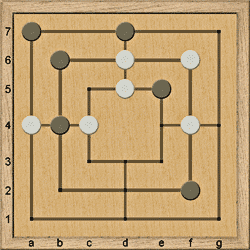|
 |
Origin
This ancient game is known with different games: Merels, Nine Men´s Morris, or simply Morris. Is one of the oldest games that nowadays is still practised. The origin is quite uncertain. Similar boards have been cut into the temple at Kurna, Egypt (~1440 BC). Other boards have been found in Ceylon which were carved during the reign of Mahadithika Maha-Naga (9-21AD). European boards have been found in such places as the first city of Troy, within a Bronze age burial site in Ireland and at the Acropolis in Athens. The game reached its peak popularity in Europe during the Fourteenth Century. It used to be played with black and white pebbles on a board marked out with a trowel dug into village greens as well as in Taverns on boards marked with chalk on a table.
There are several variants according to the shape of the board and the number of men used by each player (3,4,5,7,9 or 12 men). The variant offered by Ludoteka.com, played with 9 men, is the more used and interesting from the point of view of the strategy.
Description
Two players take part in the game. As shown in the next image, they use the 24 points on the board obtained with the 12 vertexes and the 12 intersections of 3 concentric squares connected in the middle of every side by perpendicular lines.

Each player use 9 different coloured pieces, the nine men´s morris.
Objective
The final goal of the game is to leave the opponent only with 2 men, or to block all the opponent men, so that they may not be moved.
The way of approaching to that objective is to build mills (three men in an straight line), which gives the right to capture one opponent man.
How the game goes on
The game has two different stages.
The fist stage starts with no pieces on the board. Players take turns to place one by one all their pieces on unoccupied points of the board. During this first stage there is no option to move the pieces already placed on the board.
The second stage starts after placing all the men. During this stage every turn entails in moving one of the own men through one of the lines to an unoccupied adjacent point of the board.
During both stages of the game mills may be built; this happens when the three points in one of the lines of the board are occupied by three men of the same colour, and the player who forms the mill must capture one of the opponent´s men; the captured man is moved from the board and may not be used again during the game.
The right to capture a man exists every time that the mill is built, even if the mill is formed by moving back one man to his previous position. The player who makes the capture selects the man to be moved between all the opponent men, but it is not allowed to remove an man who is part of some mill (unless all the opponent men are part of mills).
Once a player is reduced to three pieces, they are no longer limited to moving only to adjacent points. A piece may instead be moved to any unoccupied point on the board.
Final
The game may be won in two ways:
- By capturing 7 men, so that the opponent is reduced to two men and has no option to make new captures.
- By blocking all the opponent men so that they may not be moved.
Same as chess, the game ends in a draw if the next two cases:
- When both players make 50 moves without forming any new mill.
- When the same position is repeated three times on the board.
Play now
Play online with some other players
Related links
The Far Isles Medieval Society
Copyright © 2001-2024 Ludoteka.com Jokosare S.L. All rights reserved - Disclaimer - Contact
